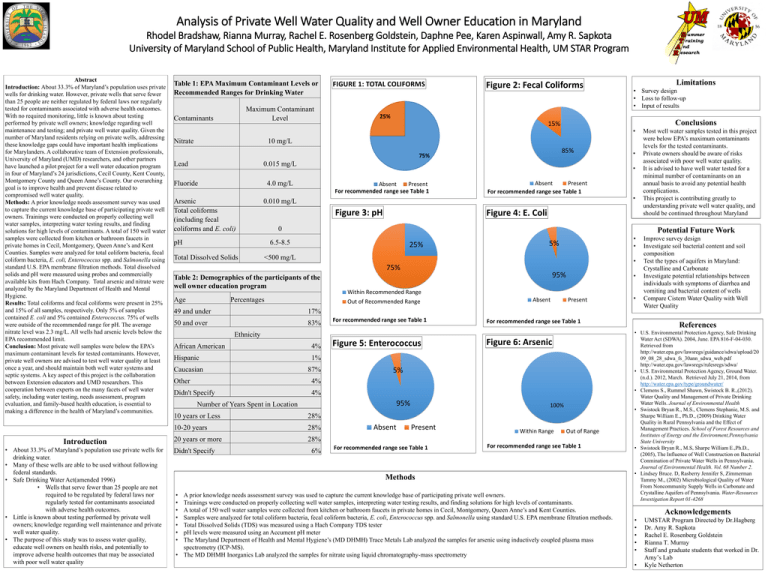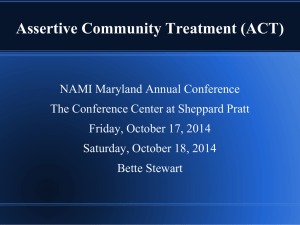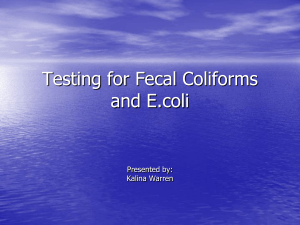Rhonda Bradshaw - The Graduate School
advertisement

Analysis of Private Well Water Quality and Well Owner Education in Maryland Rhodel Bradshaw, Rianna Murray, Rachel E. Rosenberg Goldstein, Daphne Pee, Karen Aspinwall, Amy R. Sapkota University of Maryland School of Public Health, Maryland Institute for Applied Environmental Health, UM STAR Program Abstract Introduction: About 33.3% of Maryland’s population uses private wells for drinking water. However, private wells that serve fewer than 25 people are neither regulated by federal laws nor regularly tested for contaminants associated with adverse health outcomes. With no required monitoring, little is known about testing performed by private well owners; knowledge regarding well maintenance and testing; and private well water quality. Given the number of Maryland residents relying on private wells, addressing these knowledge gaps could have important health implications for Marylanders. A collaborative team of Extension professionals, University of Maryland (UMD) researchers, and other partners have launched a pilot project for a well water education program in four of Maryland’s 24 jurisdictions, Cecil County, Kent County, Montgomery County and Queen Anne’s County. Our overarching goal is to improve health and prevent disease related to compromised well water quality. Methods: A prior knowledge needs assessment survey was used to capture the current knowledge base of participating private well owners. Trainings were conducted on properly collecting well water samples, interpreting water testing results, and finding solutions for high levels of contaminants. A total of 150 well water samples were collected from kitchen or bathroom faucets in private homes in Cecil, Montgomery, Queen Anne’s and Kent Counties. Samples were analyzed for total coliform bacteria, fecal coliform bacteria, E. coli, Enterococcus spp. and Salmonella using standard U.S. EPA membrane filtration methods. Total dissolved solids and pH were measured using probes and commercially available kits from Hach Company. Total arsenic and nitrate were analyzed by the Maryland Department of Health and Mental Hygiene. Results: Total coliforms and fecal coliforms were present in 25% and 15% of all samples, respectively. Only 5% of samples contained E. coli and 5% contained Enterococcus. 75% of wells were outside of the recommended range for pH. The average nitrate level was 2.3 mg/L. All wells had arsenic levels below the EPA recommended limit. Conclusion: Most private well samples were below the EPA’s maximum contaminant levels for tested contaminants. However, private well owners are advised to test well water quality at least once a year, and should maintain both well water systems and septic systems. A key aspect of this project is the collaboration between Extension educators and UMD researchers. This cooperation between experts on the many facets of well water safety, including water testing, needs assessment, program evaluation, and family-based health education, is essential to making a difference in the health of Maryland’s communities. Introduction • About 33.3% of Maryland’s population use private wells for drinking water. • Many of these wells are able to be used without following federal standards. • Safe Drinking Water Act(amended 1996) • Wells that serve fewer than 25 people are not required to be regulated by federal laws nor regularly tested for contaminants associated with adverse health outcomes. • Little is known about testing performed by private well owners; knowledge regarding well maintenance and private well water quality. • The purpose of this study was to assess water quality, educate well owners on health risks, and potentially to improve adverse health outcomes that may be associated with poor well water quality Table 1: EPA Maximum Contaminant Levels or Recommended Ranges for Drinking Water Maximum Contaminant Level Contaminants Nitrate FIGURE 1: TOTAL COLIFORMS Figure 2: Fecal Coliforms • Survey design • Loss to follow-up • Input of results 25% Conclusions 15% • 10 mg/L 85% 75% Lead 0.015 mg/L Fluoride Absent Present Absent Present For recommended range see Table 1 0.010 mg/L Figure 3: pH Figure 4: E. Coli 25% • • 5% <500 mg/L • 75% Table 2: Demographics of the participants of the well owner education program Percentages 95% 17% 50 and over 83% For recommended range see Table 1 Ethnicity African American 4% Hispanic 1% Caucasian 87% Other 4% Didn't Specify 4% Figure 5: Enterococcus 10 years or Less 28% 10-20 years 28% 20 years or more 28% 6% Absent Present Absent Figure 6: Arsenic 100% Present For recommended range see Table 1 • For recommended range see Table 1 5% 95% Number of Years Spent in Location • Within Recommended Range Out of Recommended Range 49 and under Didn't Specify Most well water samples tested in this project were below EPA’s maximum contaminants levels for the tested contaminants. Private owners should be aware of risks associated with poor well water quality. It is advised to have well water tested for a minimal number of contaminants on an annual basis to avoid any potential health complications. This project is contributing greatly to understanding private well water quality, and should be continued throughout Maryland Potential Future Work 6.5-8.5 Age • 0 pH Total Dissolved Solids • • 4.0 mg/L Arsenic Total coliforms (including fecal coliforms and E. coli) Within Range Out of Range For recommended range see Table 1 Methods • • • • • • • Limitations A prior knowledge needs assessment survey was used to capture the current knowledge base of participating private well owners. Trainings were conducted on properly collecting well water samples, interpreting water testing results, and finding solutions for high levels of contaminants. A total of 150 well water samples were collected from kitchen or bathroom faucets in private homes in Cecil, Montgomery, Queen Anne’s and Kent Counties. Samples were analyzed for total coliform bacteria, fecal coliform bacteria, E. coli, Enterococcus spp. and Salmonella using standard U.S. EPA membrane filtration methods. Total Dissolved Solids (TDS) was measured using a Hach Company TDS tester pH levels were measured using an Accument pH meter The Maryland Department of Health and Mental Hygiene’s (MD DHMH) Trace Metals Lab analyzed the samples for arsenic using inductively coupled plasma mass spectrometry (ICP-MS). • The MD DHMH Inorganics Lab analyzed the samples for nitrate using liquid chromatography-mass spectrometry Improve survey design Investigate soil bacterial content and soil composition Test the types of aquifers in Maryland: Crystalline and Carbonate Investigate potential relationships between individuals with symptoms of diarrhea and vomiting and bacterial content of wells Compare Cistern Water Quality with Well Water Quality References • U.S. Environmental Protection Agency, Safe Drinking Water Act (SDWA). 2004, June. EPA 816-F-04-030. Retrieved from http://water.epa.gov/lawsregs/guidance/sdwa/upload/20 09_08_28_sdwa_fs_30ann_sdwa_web.pdf http://water.epa.gov/lawsregs/rulesregs/sdwa/ • U.S. Environmental Protection Agency, Ground Water. (n.d.). 2012, March. Retrieved July 21, 2014, from http://water.epa.gov/type/groundwater/ • Clemens S., Rummel Shawn, Swistock B. R.,(2012). Water Quality and Management of Private Drinking Water Wells. Journal of Environmental Health • Swistock Bryan R., M.S., Clemens Stephanie, M.S. and Sharpe William E., Ph.D., (2009) Drinking Water Quality in Rural Pennsylvania and the Effect of Management Practices. School of Forest Resources and Institutes of Energy and the Environment,Pennsylvania State University • Swistock Bryan R., M.S, Sharpe William E.,Ph.D., (2005), The Influence of Well Construction on Bacterial Conmination of Private Water Wells in Pennsylvania. Journal of Environmental Health. Vol. 68 Number 2. • Lindsey Bruce. D, Rasberry Jennifer S, Zimmerman Tammy M., (2002) Microbiological Quality of Water From Noncommunity Supply Wells in Carbonate and Crystalline Aquifers of Pennsylvania. Water-Resources Investigation Report 01-4268 Acknowledgements • • • • • • UMSTAR Program Directed by Dr.Hagberg Dr. Amy R. Sapkota Rachel E. Rosenberg Goldstein Rianna T. Murray Staff and graduate students that worked in Dr. Amy’s Lab Kyle Netherton








